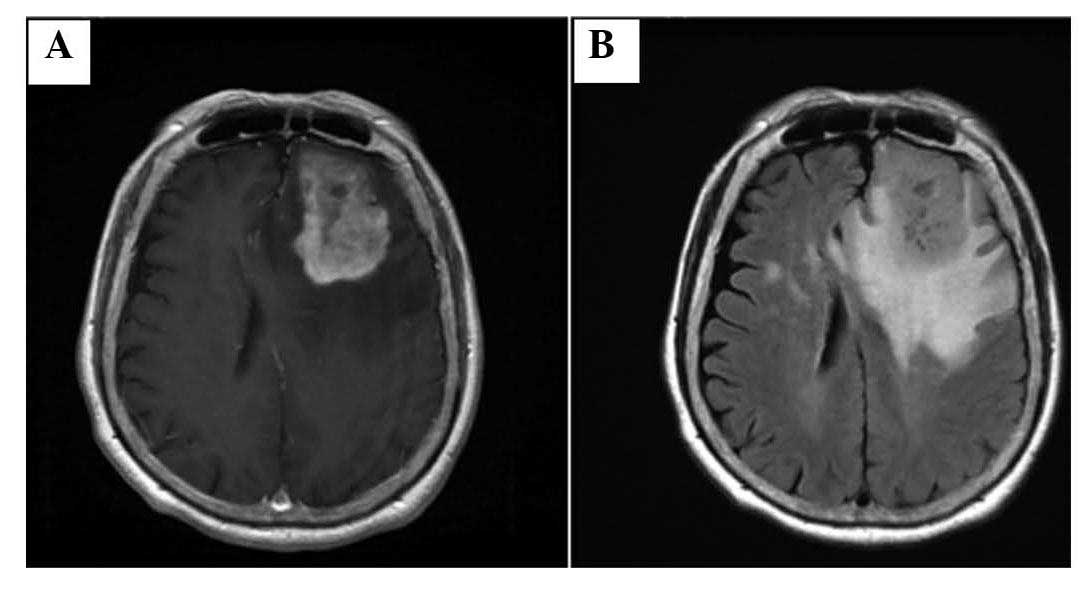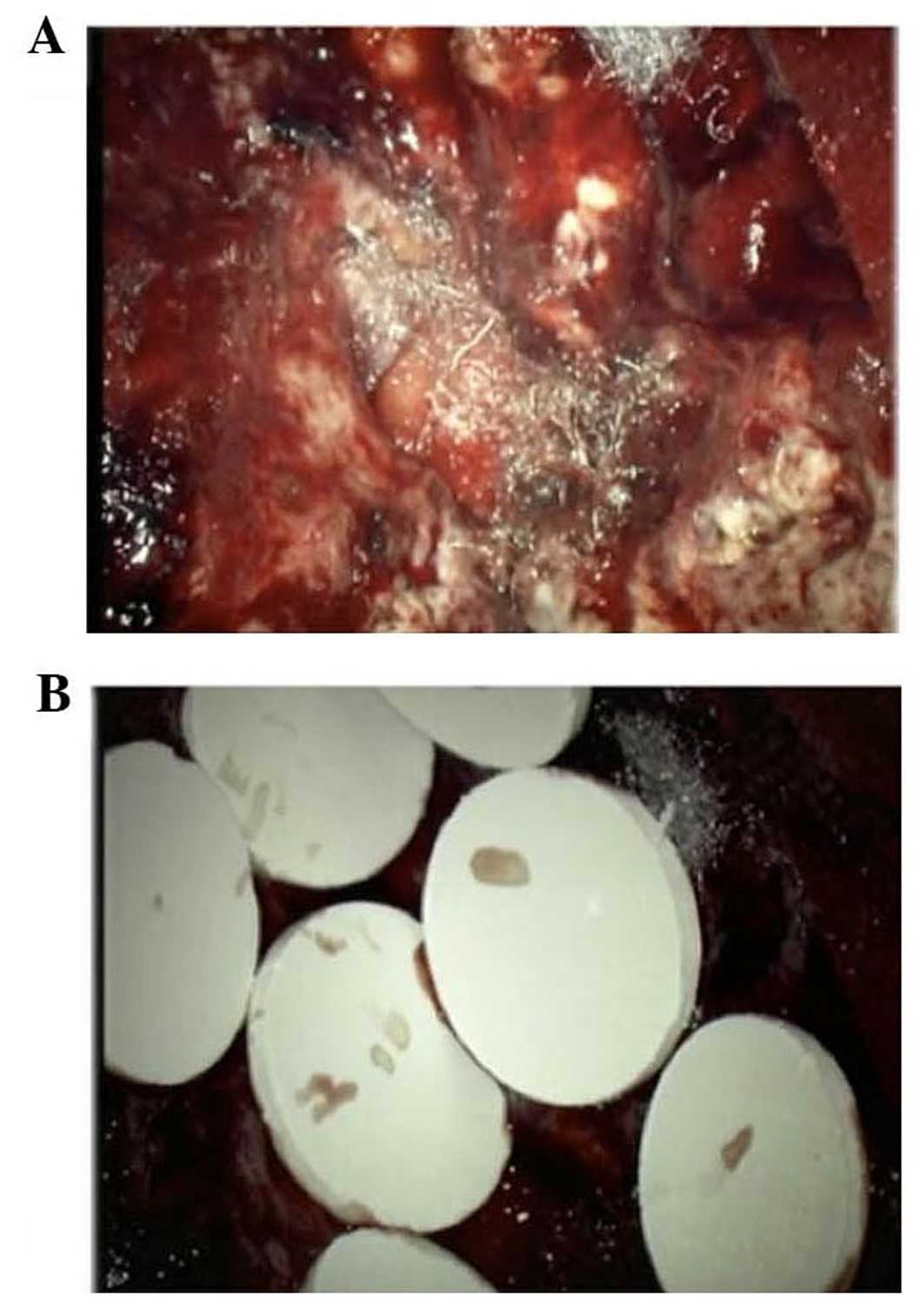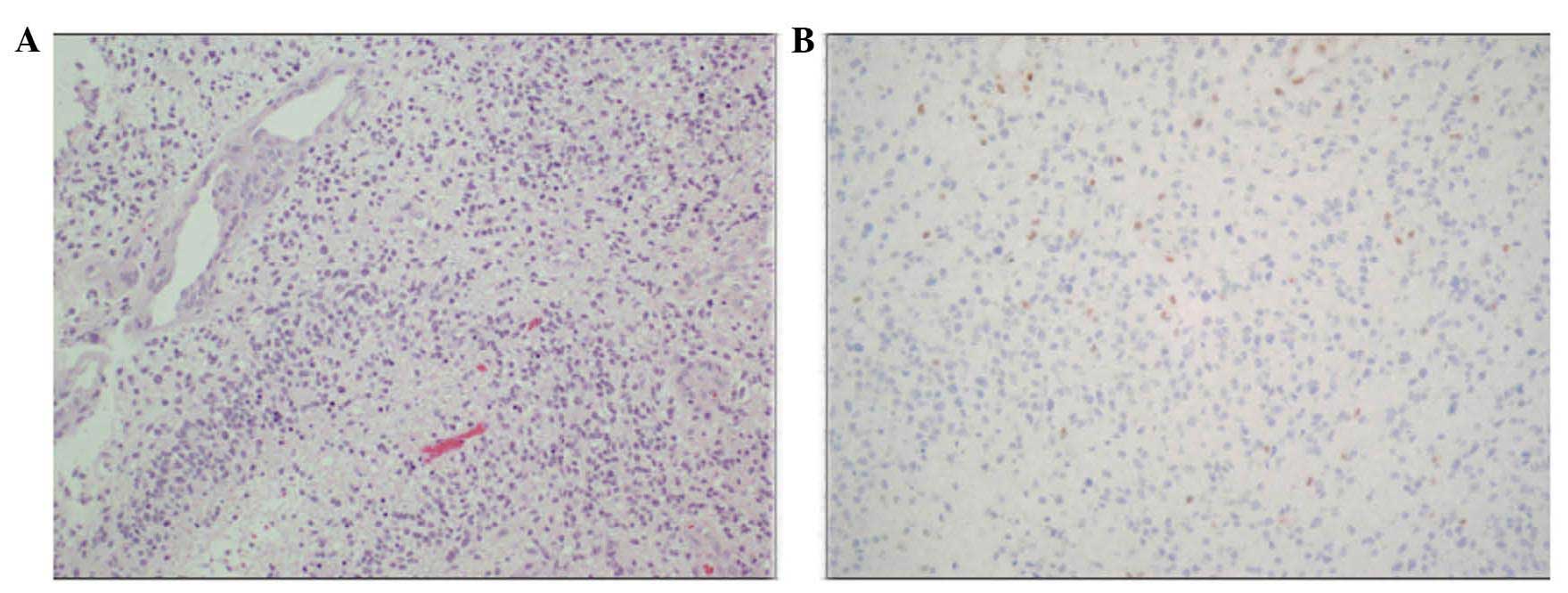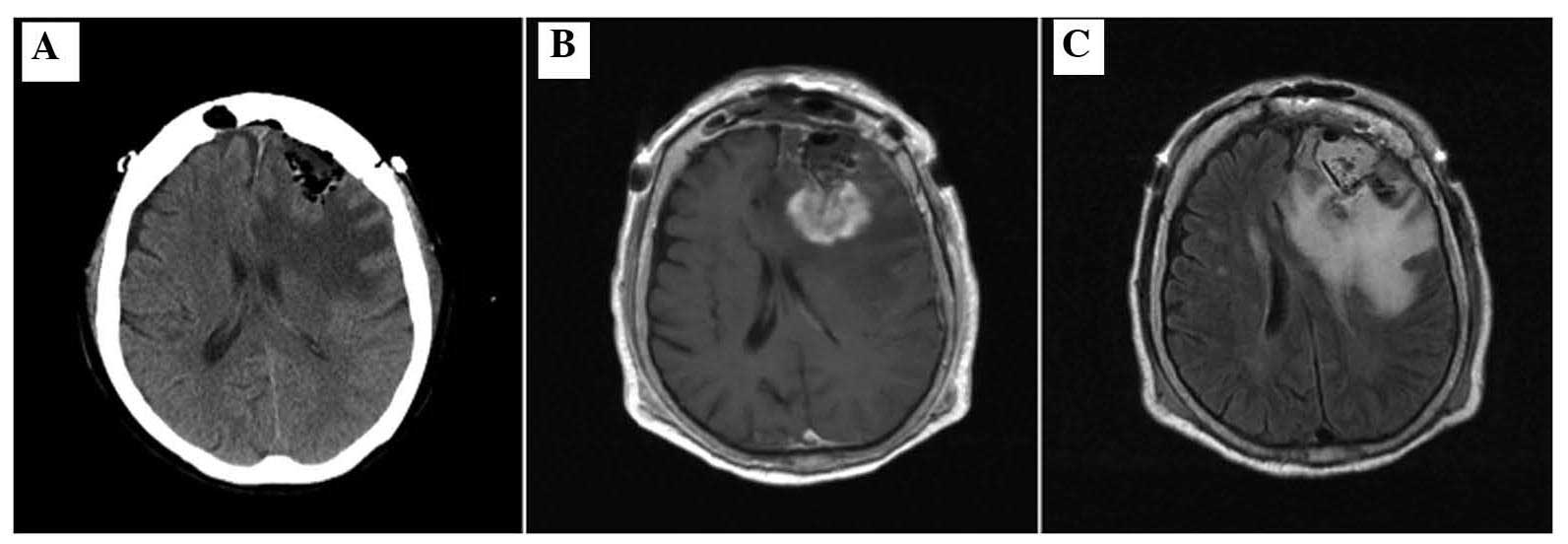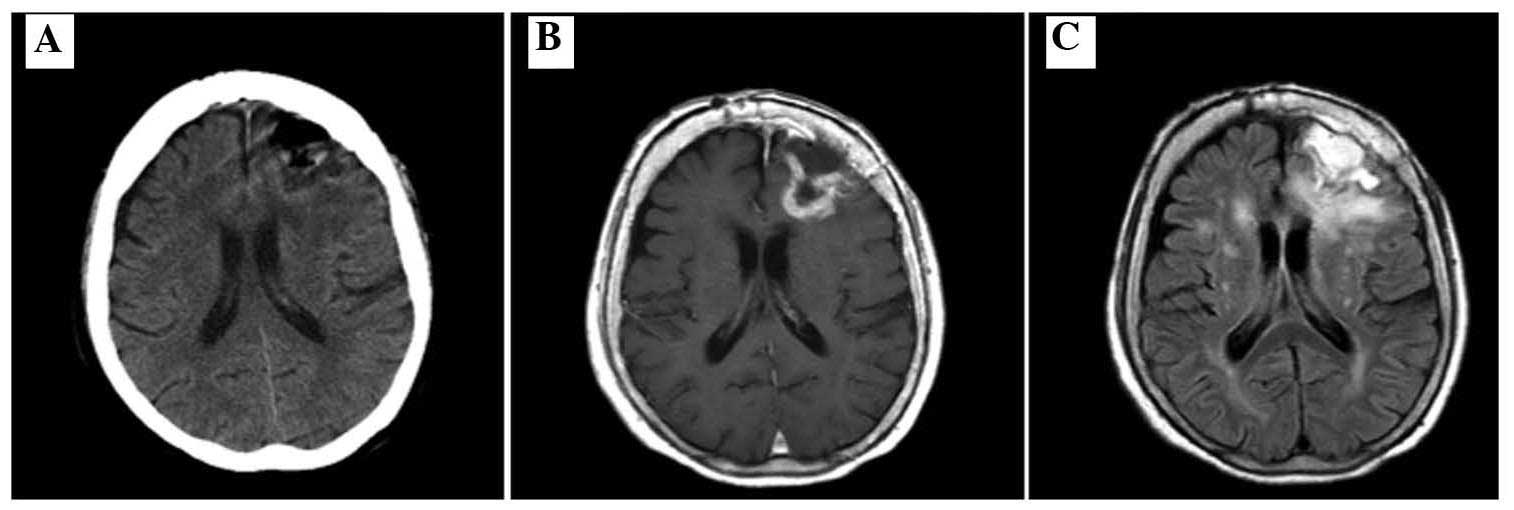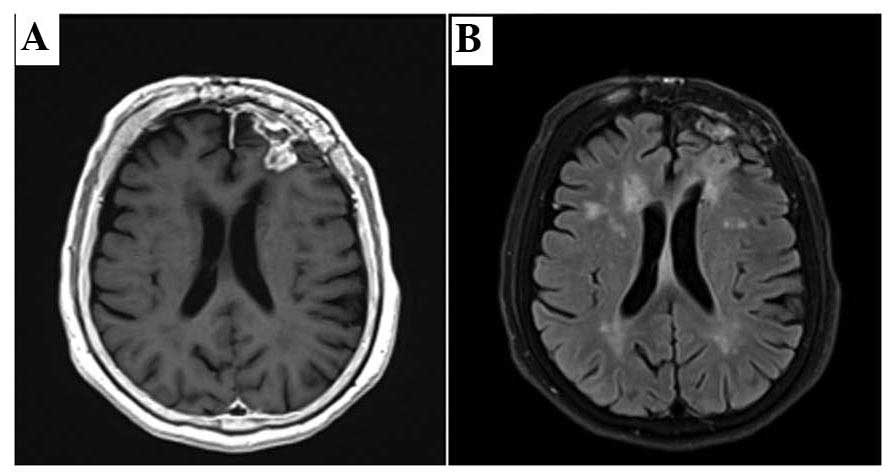Rapid regression of glioblastoma following carmustine wafer implantation: A case report
- Authors:
- Published online on: May 10, 2016 https://doi.org/10.3892/mco.2016.894
- Pages: 153-157
Abstract
Introduction
Glioblastoma (GB), a frequent type of malignant glioma, is the most common primary brain tumor and is associated with a poor prognosis. Despite aggressive multimodality treatments, including cytoreductive surgery, radiotherapy (RT) and systemic chemotherapy, GB recurs and it is invariably fatal. Additional therapeutic strategies are urgently required to elicit prolong tumor control and patient survival (1).
A carmustine (bis-chloroethylnitrosourea, BCNU; an alkylating agent of the nitrosourea family) wafer (Gliadel®; Eisai Inc., Tokyo, Japan) is a controlled-release preparation of BCNU that is implanted into the brain (2). Carmustine wafers, lined along the wall of the resection cavity following tumor removal, exert antitumor effects on the residual tumor as adjuvant local chemotherapy. This implant has been shown to enhance the overall survival of patients with malignant gliomas in controlled clinical trials in the United States and Europe (3). A prospective, multicenter phase-I/II study on Japanese patients was recently performed and the application of carmustine wafers has been covered by Japanese public health insurance since 2012 (2).
Through local application, an increased concentration of carmustine may be delivered to the tumor bed over a period of ≥3 weeks, during which, local reactions caused by this chemotherapeutic may occur (4). Previous studies have described distinctive changes on computed tomography (CT) and magnetic resonance (MR) imaging, including brain edema, gas retention and cyst formation, almost all of which are frequently discussed as adverse events and complications (4–7). To the best of our knowledge, favorable responses during the acute phase have not been reported to date.
We herein present the first reported case of GB, which rapidly regressed, as observed on CT and MRI scans, following partial tumor removal and carmustine wafer implantation. Based on the example of this case, the pharmacological prediction and surgical indication of carmustine wafer therapy were also discussed.
Case report
History
A 77-year-old Japanese woman presented with speech disturbance that aggravated over the next month, followed by gait unsteadiness. The patient had a past history of chronic obstructive pulmonary disease, which required medical treatment at that time.
Examination
The physical examination revealed mild motor aphasia and right hemiparesis. MRI revealed a tumor in the left frontal lobe of the brain (Fig. 1).
Operation
Due to its eloquent location, the tumor was partially removed under 5-aminolevulinic acid fluorescence guidance and 8 carmustine wafers were implanted in the resection cavity (Fig. 2).
Pathological findings
Histological examination revealed a highly cellular tumor composed of atypical glial cells (Fig. 3A). Mitoses, necrosis and microvascular proliferation were observed. The tumor cells were scarcely immunoreactive for O6-methylguanine-DNA methyltransferase (MGMT) (Fig. 3B). The molecular immunology Borstel-1 (MIB-1) staining index was ~10%. Genetic analysis revealed a methylated MGMT gene promoter and wild-type isocitrate dehydrogenase (IDH)1 and −2 genes (Table I). These pathological findings suggested the diagnosis of GB.
Postoperative course
Postoperative CT and MRI scans revealed the presence of residual disease and perifocal edema with a mass effect (Fig. 4). Postoperatively, steroids were administered and no additional deterioration was observed. Adjuvant treatment was planned: 150–200 mg/m2/day temozolomide (TMZ) for 5 days every 4 weeks without radiation until disease progression. Shortly after the initiation of TMZ chemotherapy, adverse effects, including fever and diarrhea, developed and TMZ was discontinued. At that time, only 300 mg of TMZ had been administered in total. A CT scan after 1 week revealed a decreased mass effect of the lesion (Fig. 5A) and a subsequent MRI revealed marked regression of the residual tumor and perifocal edema (Fig. 5B and C). After the patient's general condition improved (~3.5 months after operation), adjuvant TMZ was re-introduced every 2 months, until disease progression. The treatment was beneficial, the tumor regressed and the patient's symptoms and signs resolved (Fig. 6). The patient remains progression-free for >12 months after the operation.
Ethical approval and informed consent
Written informed consent was obtained from the patient for publication of this case report and any accompanying images. The protocol of the study was ethically approved by the Institutional Review Board of the Wakayama Medical University (permit no. 61).
Discussion
For low- as well as high-grade gliomas, extensive surgical resection is associated with longer patient survival (8). However, the extent of resection in eloquent areas of the brain is limited, in order to avoid the development of additional neurological deficits and performance deterioration. The residual tumor should be controlled by additional treatment modalities, including radiation and/or chemotherapy. Carmustine wafer implantation in the resection cavity containing the residual tumor may be promising as local chemotherapy. The present case demonstrated an unexpected rapid regression and good local control, despite only partial removal of the tumor. We hypothesize that this favourable result within only 1 month postoperatively is mainly attributed to the carmustine wafers.
RT plus concomitant and adjuvant TMZ, an alkylating agent, currently represents the standard of care for newly diagnosed GB patients (9). Consequently, carmustine wafers may be implanted concomitantly with these combined standard treatments. The rationale underlying this type of local therapy is to fill the gap between surgery and adjuvant treatments to maintain alkylating treatment pressure on residual tumor cells (10). However, in the present case, carmustine wafers were so effective that the residual tumor had markedly regressed when systemic TMZ chemotherapy was initiated, indicating that the outcome of adjuvant therapy was mainly affected by the carmustine wafers.
Methylation of the MGMT gene promoter and low expression of the MGMT protein have been associated with responsiveness to systemic carmustine chemotherapy, an increase in overall survival and the time-to-progression of the disease (11). A pharmacokinetic analysis indicated that exposure of the tissue area to carmustine under a concentration-time curve achieved by polymeric delivery was 4–1,200-fold higher compared with that produced by intravenous administration of a higher dose; however, the MGMT status should be considered as the main factor that limits the efficacy of carmustine wafers (12). Indeed, in patients with newly diagnosed GB who underwent surgical resection and received carmustine wafer implants followed by adjuvant radiotherapy and concomitant oral TMZ chemotherapy, MGMT promoter methylation status and low MGMT expression were identified as positive prognostic factors (10). In the present case, the tumor was highly responsive to carmustine wafers, and also exhibited genetic characteristics conferring sensitivity to alkylating agents.
Previous pharmacokinetic studies on animals and associated modelling demonstrated the ability of carmustine wafers to produce high-dose delivery (millimolar concentrations) within millimeters of the polymer implant, with a limited penetration distance of carmustine from the site of delivery (13). In addition, the presence of significant doses of carmustine in more distant regions of the brain (centimeters away from the carmustine wafer implant) has been shown to persist over the course of 1 week in non-human primates (13). However, Fung et al (12) revealed that a significant concentration of carmustine (0.4 µM) was detected at up to 5 cm from the implant as late as 30 days after implantation, although a high drug concentration (0.5–3.5 mM) was measured within 3 mm. Therefore, it may be preferable for carmustine wafers to be placed as close to the residual tumor as possible. We consider that effective placement of wafers was accomplished in the present case.
For GB patients subjected to ≥90% resection in the BCNU wafer study, the median survival increased compared with that of placebo-treated controls, while no further survival increase was found for cases with <90% resection (14). However, to date, no evidence-based recommendations are available to guide implantation decisions based on the extent of tumor resection (15). Gutenberg et al (15) recommended that wafer implantation should only be planned if gross total resection appears feasible, if tumor resection leads to a significant reduction of the mass effect and if the resulting resection cavity is of sufficient size for wafer implantation. As demonstrated in the present case, although the tumor was only partially resected, it was considered that carmustine wafers could be implanted if the mass effect was significantly reduced and the resection cavity was of sufficient size. However, one should always consider the possibility of brain edema, resulting in severe, albeit transient, neurological deficits (15).
Although surgical resection followed by RT with concurrent and adjuvant TMZ is the standard of care for non-elderly patients with GB, the safety and efficacy of these modalities in elderly patients are less certain, as this population is underrepresented in several clinical trials (16). According to the recent literature, however, the use of TMZ in elderly patients appears to be safe, when administered to, or as a substitute for, RT (16). In particular, among elderly patients with GB harboring MGMT promoter methylation, the addition of adjuvant TMZ to RT or the substitution of TMZ for RT is likely to prolong survival compared with RT alone (16–18). Due to the marked toxicity of available therapies and increased prevalence of comorbidities in elderly patients, the ability of each individual patient to receive treatment requires consideration prior to treatment. In the present case, adjuvant TMZ monotherapy was reasonable and beneficial, considering the performance status and genetic profile of the patient.
In conclusion, we herein reported the case of an elderly patient with GB in an eloquent region of the brain (left frontal lobe). Despite the opinion that a palliative treatment strategy may be more appropriate compared with an aggressive multimodal regimen in such a case, partial removal of the tumor was followed by placement of carmustine wafers (15). As a result, marked regression of the residual tumor was observed, without any adverse effects, within a short time after surgery. The present case demonstrated a marked antitumor effect of carmustine wafers, which, to the best of our knowledge, had not been reported to date. Considering the possible adverse events, carmustine wafer implantation may be planned if the size of the resulting resection cavity is sufficient for wafer placement, even if total gross resection does not appear to be feasible.
Glossary
Abbreviations
Abbreviations:
|
MGMT |
O6-methylguanine-DNA methyltransferase |
|
GB |
glioblastoma |
|
RT |
radiotherapy |
|
BCNU |
bis-chloroethylnitrosourea |
|
MG |
malignant gliomas |
|
MR |
magnetic resonance |
|
IDH |
isocitrate dehydrogenase |
|
TMZ |
temozolomide |
References
|
Broniscer A, Tatevossian RG, Sabin ND, et al: Clinical, radiological, histological, and molecular characteristics of paediatric epithelioid glioblastoma. Neuropathol Appl Neurobiol. 40:327–336. 2014. View Article : Google Scholar : PubMed/NCBI | |
|
Aoki T, Nishikawa R, Sugiyama K, Nonoguchi N, Kawabata N, Mishima K, Adachi J, Kurisu K, Yamasaki F, Tominaga T, et al: A multicenter phase I/II study of the BCNU implant (Gliadel® Wafer) for Japanese patients with malignant gliomas. Neurol Med Chir (Tokyo). 54:290–301. 2014. View Article : Google Scholar : PubMed/NCBI | |
|
Westphal M, Hilt DC, Bortey E, Delavault P, Olivares R, Warnke PC, Whittle IR, Jääskeläinen J and Ram Z: A phase 3 trial of local chemotherapy with biodegradable carmustine (BCNU) wafers (Gliadel wafers) in patients with primary malignant glioma. Neurol Oncol. 5:79–88. 2003. View Article : Google Scholar | |
|
Ulmer S, Spalek K, Nabavi A, Schultka S, Mehdorn HM, Kesari S and Dörner L: Temporal changes in magnetic resonance imaging characteristics of Gliadel wafers and of the adjacent brain parenchyma. Neuro Oncol. 14:482–490. 2012. View Article : Google Scholar : PubMed/NCBI | |
|
Colen RR, Zinn PO, Hazany S, Do-Dai D, Wu JK, Yao K and Zhu JJ: Magnetic resonance imaging appearance and changes on intracavitary Gliadel wafer placement: A pilot study. World J Radiol. 3:266–272. 2011. View Article : Google Scholar : PubMed/NCBI | |
|
Hammoud DA, Belden CJ, Ho AC, Dal Pan GJ, Herskovits EH, Hilt DC, Brem H and Pomper MG: The surgical bed after BCNU polymer wafer placement for recurrent glioma: Serial assessment on CT and MR imaging. AJR Am J Roentgenol. 180:1469–1475. 2003. View Article : Google Scholar : PubMed/NCBI | |
|
Prager JM, Grenier Y, Cozzens JW, Chiowanich P, Gorey MT and Meyer JR: Serial CT and MR imaging of carmustine wafers. AJNR Am J Neuroradiol. 21:119–123. 2000.PubMed/NCBI | |
|
Sanai N and Berger MS: Glioma extent of resection and its impact on patient outcome. Neurosurgery. 62:753–764; discussion 264–266. 2008. View Article : Google Scholar : PubMed/NCBI | |
|
Fukai J, Koizumi F and Nakao N: Enhanced anti-tumor effect of zoledronic acid combined with temozolomide against human malignant glioma cell expressing O6-methylguanine DNA methyltransferase. PLoS One. 9:e1045382014. View Article : Google Scholar : PubMed/NCBI | |
|
Lechapt-Zalcman E, Levallet G, Dugué AE, et al: O(6)-methylguanine-DNA methyltransferase (MGMT) promoter methylation and low MGMT-encoded protein expression as prognostic markers in glioblastoma patients treated with biodegradable carmustine wafer implants after initial surgery followed by radiotherapy with concomitant and adjuvant temozolomide. Cancer. 118:4545–4554. 2012. View Article : Google Scholar : PubMed/NCBI | |
|
Esteller M, Garcia-Foncillas J, Andion E, et al: Inactivation of the DNA-repair gene MGMT and the clinical response of gliomas to alkylating agents. N Engl J Med. 343:1350–1354. 2000. View Article : Google Scholar : PubMed/NCBI | |
|
Fung LK, Ewend MG, Sills A, Sipos EP, Thompson R, Watts M, Colvin OM, Brem H and Saltzman WM: Pharmacokinetics of interstitial delivery of carmustine, 4-hydroperoxycyclophosphamide, and paclitaxel from a biodegradable polymer implant in the monkey brain. Cancer Res. 58:672–684. 1998.PubMed/NCBI | |
|
Fleming AB and Saltzman WM: Pharmacokinetics of the carmustine implant. Clin Pharmacokinet. 41:403–419. 2002. View Article : Google Scholar : PubMed/NCBI | |
|
Stummer W, van den Bent MJ and Westphal M: Cytoreductive surgery of glioblastoma as the key to successful adjuvant therapies: New arguments in an old discussion. Acta Neurochir (Vienna). 153:1211–1218. 2011. View Article : Google Scholar | |
|
Gutenberg A, Lumenta CB, Braunsdorf WE, Sabel M, Mehdorn HM, Westphal M and Giese A: The combination of carmustine wafers and temozolomide for the treatment of malignant gliomas. A comprehensive review of the rationale and clinical experience. J Neurooncol. 113:163–174. 2013. View Article : Google Scholar : PubMed/NCBI | |
|
Jordan JT, Gerstner ER, Batchelor TT, Cahill DP and Plotkin SR: Glioblastoma care in the elderly. Cancer. 122:189–197. 2016. View Article : Google Scholar : PubMed/NCBI | |
|
Malmström A, Grønberg BH, Marosi C, et al: Temozolomide versus standard 6-week radiotherapy versus hypofractionated radiotherapy in patients older than 60 years with glioblastoma: The Nordic randomised, phase 3 trial. Lancet Oncol. 13:916–926. 2012. View Article : Google Scholar : PubMed/NCBI | |
|
Wick W, Platten M, Meisner C, et al: Temozolomide chemotherapy alone versus radiotherapy alone for malignant astrocytoma in the elderly: The NOA-08 randomised, phase 3 trial. Lancet Oncol. 13:707–715. 2012. View Article : Google Scholar : PubMed/NCBI |



